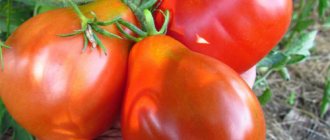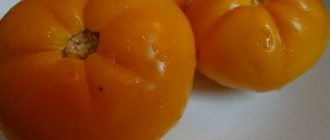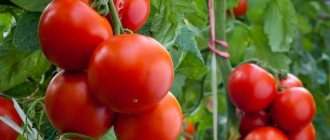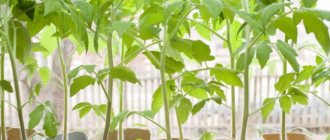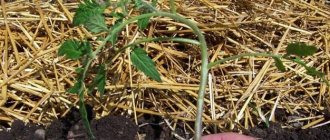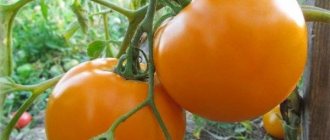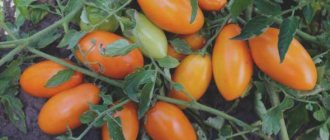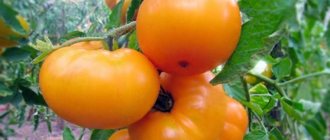Among the tomatoes in the “Japanese Truffle” series, the Yellow Truffle variety occupies a special place. Like all yellow-fruited tomatoes, it has increased sweetness and juiciness. Bright fruits can transform any vegetable dish and look beautiful in jars.
| Height | Landing location | Ripening time | Fruit color | Fruit size | Origin | Fruit shape |
| Tall | Greenhouse, Open ground | Mid-season | Orange | Average | Variety | Pear-shaped |
General characteristics
"Yellow Truffle" is a mid-season variety. From the appearance of the first shoots to fruiting – 110-120 days. It can be grown both in a greenhouse and in beds. Tomatoes have a slightly ribbed surface and a pear-shaped shape. Something like a truffle. The taste of the fruits of this variety is sweet, the flesh is fleshy, thick. The color of the tomato is orange-yellow, weight is about 100-150 g. Suitable for preparing fresh salads, not bad for pickling in its entirety.
Its main difference is its good ability to set fruit. Shows the best results when grown in a greenhouse. This is because it can grow up to 3 m. One bunch can ripen 6-7 tomatoes.
Interesting! Many breeders have developed a low-growing variety of this tomato. In open beds, such a plant grows no more than 70 cm.
Description and characteristics of the variety
Yellow Truffle tomato seeds are sold by Siberian Garden. This is a mid-season variety, ripening after 100-115 days from germination. Growth is unlimited: in open ground it reaches 150 cm in a greenhouse – 180 cm.
The cultivar is intended for greenhouses and open ground, grown for canning and commercial purposes. Dense, transportable tomatoes are suitable for sale, processing into juice and tomato products. But they are especially delicious fresh. They contain a high content of beta-carotene, a substance that improves vision and skin condition.
Yellow tomatoes are suitable for baby and diet food, as they contain a minimal amount of acids.
The fruits are pear-shaped. The stalk has well-defined vertical ribs. There are specimens without ribbing. They are shaped most like small light bulbs. Well-ripened tomatoes have a yellow-orange color and excellent taste. 5-6 fruits ripen in a cluster with an average weight of 140 g.
Growing seedlings
You can sow tomatoes for seedlings as early as March. If you are going to plant it in the future in a heated greenhouse, then planting can be done in April. If the greenhouse is not heated, then the seedlings are planted no earlier than May. As for open beds, you need to watch the weather forecast. The plant should be planted in the beds after all frosts have ended. Most often this happens towards the end of May. By this time, the plants should reach the age of 60-65 days.
Low-growing varieties should be planted 2-4 bushes per 1 m2, tall ones - 5-6. Tall ones most often form two stems. In this case, the second one is obtained from the stepson under the first brush. The remaining stepsons are removed, as are the lower five leaves. The growth of the bush should be limited to 6-7 brushes. Tall stems require a garter and vertical support.
Attention! This variety should be watered exclusively with heated water.
Advantages:
- the fruits are suitable for special nutrition;
- can be used by people with allergic reactions;
- contains a large amount of vitamins and antioxidants;
- the variety is resistant to diseases of fungal origin;
- tolerates any weather conditions well.
Tomato Truffle yellow: variety description
This tomato variety is of an indeterminate type with unlimited growth power of the central stem.
. In greenhouse conditions, the plant grows up to 1.5 m in height, and in garden beds the height of tomato bushes is lower.
When growing a Yellow Truffle tomato, its bushes are usually formed into one or two stems for this purpose. to get bigger yields.
When forming a plant into one shoot on a bush, all the stepsons that appear in the axils of the leaves are removed. When forming into a pair of shoots, the stepson that appears above the first flower inflorescence is left, which will become the second stem.
Tomato Yellow Truffle - video
When growing bushes of the Truffle yellow variety, they must be tied to strong supports, otherwise the shoots may break under the weight of ripening fruits.
Reference!
The Yellow Truffle tomato belongs to the mid-season varieties, and about 4 months pass from the moment of germination of the seed material to the harvesting of ripe yellow fruits
The shoots are quite strong, medium leafy. The foliage is of medium length, narrow, with sparse small teeth along the edges, shiny, dark emerald color.
The flowers are small, yellow, collected in racemes. Each of them can form up to 7 ovaries.
Interesting!
Some breeders, as an experiment, developed a determinate variety of this tomato, the size of the bushes is small - up to 0.7 m.
The variety got its name from the original shape of the fruit. They are pear-shaped, with small ribs, very similar to a truffle mushroom.
The skin is compacted, smooth, shiny, at the stage of technical maturity - orange in color with an orange tint. The pulp is dense, fleshy, with a large number of chambers (at least 5), there is little seed material. The taste of ripe tomato fruits Yellow truffle is sweet, almost no sourness is felt
.
The weight of ripe tomatoes can be up to 120-150 g.
Tomato harvest Yellow truffle
Ripe tomatoes are not prone to cracking and can withstand transportation well over different distances. Under appropriate conditions, the harvested crop can be stored for at least 2-2.5 weeks.
How to care for the “Yellow Truffle” in open beds
The tomato is a very unpretentious plant, but despite this, it is quite responsive to any care measures. Thus, it turns out that the care shown to him will return to you in a rich harvest.
It is important here not to overdo it with care. After all, tomatoes do not like large amounts of moisture, excess fertilizer, or drought. You should determine the best number of all manipulations that you will perform in the beds.
First of all, you should determine the necessary care for plants.
This:
- optimal watering;
- timely feeding;
- loosening the soil and ridding plants of weeds;
- garter and stepson;
- hilling;
- protection from pests and diseases.
Advantages and disadvantages
Positive traits:
- bears fruit until frost;
- interesting sweet taste with slight sourness;
- ease of care;
- successfully resists diseases;
- suitable for salads and whole-fruit preparations;
- tomatoes picked from the bush ripen quickly at home;
- recumbent.
Flaws:
- During summer cold snaps in the middle zone, tomatoes planted in open ground stop growing, the tops turn blue and recover for a long time after that.
How to water tomatoes correctly
After planting plants in the soil, you just need to care for them promptly and correctly. The most important thing is watering. The secret of “correct” watering is moderate soil moisture. The plant should be watered as the soil dries, but not allowed to dry out. Because it could destroy them.
Watering approximately once a week is considered the most optimal.
Important! The best way to water tomatoes is with a drip irrigation system.
Care
The bushes are formed into 1 or 2 stems: the side shoots are broken off and the growing point is pinched. The lower leaves are also removed, but gradually (no more than 3 pieces at a time).
():
Pinching the top (topping) is carried out approximately a month before the end of the tomato growing season in the ground. This period will vary in different regions. In cold areas, pinching is done already at the end of July. In the middle zone - in mid-August. In the south, indeterminate tomatoes do not grow if the size of the greenhouse allows.
Water tomatoes every 10 days, and in hot weather - every week. Fertilizing is done 2 times a month, if possible combined with watering. After moistening the soil, mulch with dry leaves, hay or peat.
If it is not mulched, it is regularly loosened and weeded. The greenhouse is ventilated daily so that the increased level of humidity does not contribute to the development of late blight and rot.
As a preventive measure, plants are watered with manganese or ash solution, sprayed with calcium nitrate, copper sulfate, and Bordeaux mixture. The leaves are regularly checked for the presence of aphids or other insects, and at the first signs of damage, they are washed with a soap solution and sprayed with biological products or insecticides.
Tomato variety TRUFFLE YELLOW
Tomato variety “Truffle yellow”
Tomato Japanese Truffle Orange
Plant nutrition
The smallest number of feeding activities is about three, but the best option is to fertilize the plants once every two weeks. To do this, you can use fertilizers that contain a lot of phosphorus and potassium, and a small amount of nitrogen.
You can use the following:
- 10 liters of water;
- 30-40 g of potassium chloride;
- 15 g of saltpeter;
- 50-60 g of superphosphate.
You can also use a solution of bird droppings, and during flowering - boron.
Tomato variety Truffle: growing features
Truffle tomatoes: photo of variety
The Red Truffle tomato is no exception - it must be grown using seedlings.
By the time seedlings are planted in a greenhouse or soil, they should be about two months old (about 20-25 cm tall and an average of six true leaves), so calculate the timing of sowing seeds depending on this.
For the first couple of weeks, Truffle tomato seedlings should be kept at a temperature of +15...+17 degrees so that they do not start growing suddenly. And then, when the sprouts get stronger, maintain a comfortable +22…+25 degrees.
Water carefully at the root, only after the soil has dried. It is very dangerous to overwater seedlings, as there is a risk of blackleg disease.
At first, the plants will have enough nutrition (purchased soil for seedlings is enriched with nutrients). But closer to the time of transplantation, you can feed the seedlings with complex mineral fertilizer or organic matter.
Determine the time for transplanting Truffle tomato seedlings to a permanent place depending on the weather. Frosts should finally pass, and the soil should warm up by at least 15 degrees. At the time of transplantation, apply fertilizer and water the soil well. And then the plants should be left alone for 7-10 days. This will give them the opportunity to take root and adapt to a new place.
After some time, you can fertilize with nitrogen, since after replanting the plants need to grow greenery, which means that nitrogen is especially necessary now. But after the first flowers appear, there is no need to apply any more nitrogen fertilizers. During the flowering and fruiting period, they need potassium and phosphorus fertilizers.
Growing Red Truffle tomatoes (as well as Black Truffle and Japanese Truffle tomatoes) is not difficult for an experienced gardener. But if you are new to gardening, then this does not change anything. There is no need to be afraid, you can start mastering the cultivation of tomatoes from any variety, if you wish. And numerous reviews from summer residents are proof of this.
Tomato Truffle red: video about the variety
